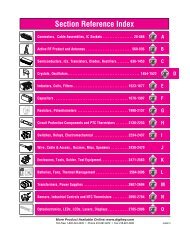Microcontroller Solutions TechZone Magazine, April 2011 - Digikey
Microcontroller Solutions TechZone Magazine, April 2011 - Digikey
Microcontroller Solutions TechZone Magazine, April 2011 - Digikey
You also want an ePaper? Increase the reach of your titles
YUMPU automatically turns print PDFs into web optimized ePapers that Google loves.
The Heartbeat Behind Portable<br />
Medical Devices: Ultra-Low-Power<br />
Mixed-Signal <strong>Microcontroller</strong>s<br />
by Shahram Tadayon, Silicon Laboratories<br />
Low-power, low-noise, low-cost MCUs are<br />
powering the next generation of portable<br />
medical devices.<br />
The proliferation of sophisticated yet affordable personal medical devices is<br />
transforming the health care industry, enabling consumers to monitor vital<br />
signs and other key aspects of their health at home and on the go without<br />
costly and inconvenient visits to the doctor’s office. According to Gartner,<br />
Inc., portable consumer medical devices such as blood glucose monitors,<br />
blood pressure monitors, insulin pumps, and heart rate monitors, represent<br />
the fastest-growing segment in the medical equipment market. A recent<br />
medical semiconductor report by Databeans projects that the home medical<br />
device segment will experience a compound annual growth rate (CAGR) of<br />
nine percent over the next five years.<br />
The explosive growth of the personal medical device market stems<br />
from a variety of factors: a steadily “graying” (aging) population<br />
requiring more frequent health monitoring; skyrocketing costs of<br />
traditional physician-directed medical care; growing consumer<br />
awareness of the benefits of wellness products; widespread<br />
availability of personal medical devices, both online and in<br />
retail outlets; and the increasing sophistication, ease of use and<br />
affordability of consumer health care products enabled by continuing<br />
advances in semiconductor technology.<br />
While consumer products are generally price sensitive, the consumer<br />
portable health market adds other stringent requirements in order<br />
for devices to be successful in the market. Above all, they must be<br />
highly reliable and accurate in order to detect and help prevent health<br />
problems. These requirements are regulated by government entities<br />
such as the Food and Drug Administration (FDA) in the United States.<br />
In order to succeed in the increasingly competitive home health care<br />
market, portable medical devices should offer the following features:<br />
• Ease of use<br />
• Highly reliable and safe (government-regulated) operation<br />
• Easy, secure connectivity<br />
• Low-power operation (long battery life)<br />
• Support for a wide range of voltages (especially lower voltages)<br />
• High measurement accuracy<br />
• Small form factors<br />
• Affordable cost<br />
To be able to deliver this array of product features to consumers at<br />
economical prices, medical device developers must reduce system<br />
cost by limiting the number of discrete components within the<br />
design. Semiconductor suppliers also are tasked with supplying<br />
highly integrated embedded control solutions that enable increased<br />
performance and reliability within strict power and cost budgets.<br />
At the heart of these portable device designs are highly integrated<br />
mixed-signal microcontrollers (MCUs) designed to deliver exceptional<br />
processing performance at the lowest supply currents.<br />
Ease of use is essential for all portable medical products because it<br />
reduces errors in measurement resulting from operator error. Such<br />
devices should require minimal user interaction for proper operation,<br />
simple user input (for example, fewer buttons and simpler software<br />
menus) and large, backlit easy-to-read displays. To support these<br />
features, MCUs must provide field-programmable, non-volatile<br />
memory storage (typically in-system programmable flash memory),<br />
as well as flexible I/O configurations to make the best use of a limited<br />
number of pins.<br />
While many portable medical devices today simply display health<br />
monitoring results and leave the interpretation and logging to end users<br />
and their physicians, newer devices feature simple connectivity to log<br />
and transmit results automatically. Typically, these more sophisticated<br />
products will connect to personal computers or mobile health<br />
appliances with software that can track results, or they will securely<br />
transmit information wirelessly to medical professionals, caretakers or<br />
web-based applications – a practice known as telemedicine.<br />
The health care equipment market has adopted an optimized USB<br />
device standard, the Personal Health Care Device (PHCD) Class<br />
(Figure 1), which leverages the ubiquitous USB interface to enable<br />
standardized transmission of data and messages regardless of device<br />
manufacturer. Moving forward, wireless transmission of data<br />
Figure 1: USB personal healthcare device class supports easy connectivity.<br />
www.digikey.ca/microcontroller<br />
61














